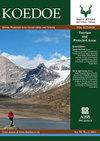Waterbird community changes in the Wilderness Lakes, South Africa (Part 1 of 3): Herbivores and omnivores
IF 1.1
4区 环境科学与生态学
Q3 BIODIVERSITY CONSERVATION
引用次数: 0
Abstract
Global and regional degradation and loss of aquatic systems can negatively affect wetland-dependent waterbirds. The Wilderness Lakes Complex in South Africa, which incorporates the Wilderness Ramsar site, supports populations of 68 waterbird species including eight which periodically occur in globally significant (1% population) numbers. The study aimed to document long-term spatial and temporal (including seasonal) patterns of abundance of herbivorous waterbirds in the Wilderness Lakes Complex, and where possible identify potential causes for observed trends. The abundance of waterbirds on these wetlands was determined biannually from 1992 to 2019, with counts conducted from a boat following a standardised route. Historical abundance data from the 1980s was also used to describe long-term abundance changes. Observed seasonality of four herbivorous waterbirds differed from published accounts. Long-term abundance trends indicated a combination of declining, increasing and stable populations which, in several instances, differed from regional (southern African) assessments. Significant long-term decreases have occurred in five herbivorous species in the lakes complex (Common Moorhen Gallinula chloropus, Red-knobbed Coot Fulica cristata, Yellow-billed Duck Anas undulata, Cape Shoveler Anas smithii, Cape Teal Anas capensis), whereas increases have occurred in two species (Spur-winged Goose Plectropterus gambensis, Egyptian Goose Alopochen aegyptiaca). Similar types of change occurred across multiple waterbodies, and in different seasons. The similarity of trends in spatially separated wetlands suggested either high interconnectivity of populations between wetland systems and/or some drivers of change of mobile species being broad scaled and regional, rather than system specific. Local reasons for changes potentially include increasing extent of cultivated fields, a proliferation of emergent macrophytes and loss of open sandbanks, changing food availability, increasing disturbance, and disease.Conservation implications: The fundamental character of the Wilderness Ramsar site has changed, with reduced abundance of several previously abundant herbivorous waterbirds. Drivers of change in species abundances are multifaceted, complex, and frequently poorly understood. Recommended local corrective actions include the management of emergent macrophytes, avian diseases, disturbance, and water quality.南非荒野湖泊中水鸟群落的变化(3 部分中的第 1 部分):食草动物和杂食动物
全球和区域的退化和水生系统的丧失会对依赖湿地的水鸟产生负面影响。南非的荒野湖泊综合体,包括拉姆萨尔荒野遗址,支持68种水鸟的种群,其中包括8种定期出现的全球重要数量(1%的种群)。该研究旨在记录荒野湖区草食性水鸟丰度的长期时空(包括季节)模式,并在可能的情况下确定观察趋势的潜在原因。从1992年到2019年,每两年对这些湿地上水鸟的丰度进行一次测定,并沿着标准化路线从船上进行计数。20世纪80年代的历史丰度数据也被用来描述长期的丰度变化。观察到的四种草食性水鸟的季节性与发表的报道不同。长期丰度趋势表明,在若干情况下,与区域(南部非洲)评估不同的是种群数量的减少、增加和稳定。湖泊群中5种草食性物种(Common Moorhen Gallinula chloropus,红节骨顶鸟Fulica cristata,黄嘴鸭Anas波动,角Shoveler Anas smithii,角Teal Anas capensis)的数量长期显著减少,而2种物种(刺翅鹅plectroterus gambensis,埃及鹅Alopochen aegyptiaca)的数量则有所增加。类似类型的变化发生在多个水体和不同的季节。在空间分隔的湿地中,趋势的相似性表明湿地系统之间种群的高度互联性和/或一些流动物种变化的驱动因素是广泛的和区域性的,而不是系统特异性的。变化的地方原因可能包括耕地面积的扩大、新兴大型植物的繁殖和开放沙洲的丧失、食物供应的变化、干扰的增加和疾病的增加。保育意义:拉姆萨尔湿地的基本特征已发生改变,数种原本丰富的草食性水鸟数量减少。物种丰度变化的驱动因素是多方面的、复杂的,而且往往知之甚少。建议的地方纠正措施包括对紧急大型植物、禽类疾病、干扰和水质的管理。
本文章由计算机程序翻译,如有差异,请以英文原文为准。
求助全文
约1分钟内获得全文
求助全文
来源期刊

Koedoe
BIODIVERSITY CONSERVATION-
CiteScore
3.30
自引率
0.00%
发文量
10
审稿时长
20 weeks
期刊介绍:
Koedoe, with the subtitle ''African Protected Area Conservation and Science'', promotes and contributes to the scientific (biological) and environmental (ecological and biodiversity) conservation practices of Africa by defining the key disciplines that will ensure the existence of a wide variety of plant and animal species in their natural environments (biological diversity) in Africa.
 求助内容:
求助内容: 应助结果提醒方式:
应助结果提醒方式:


